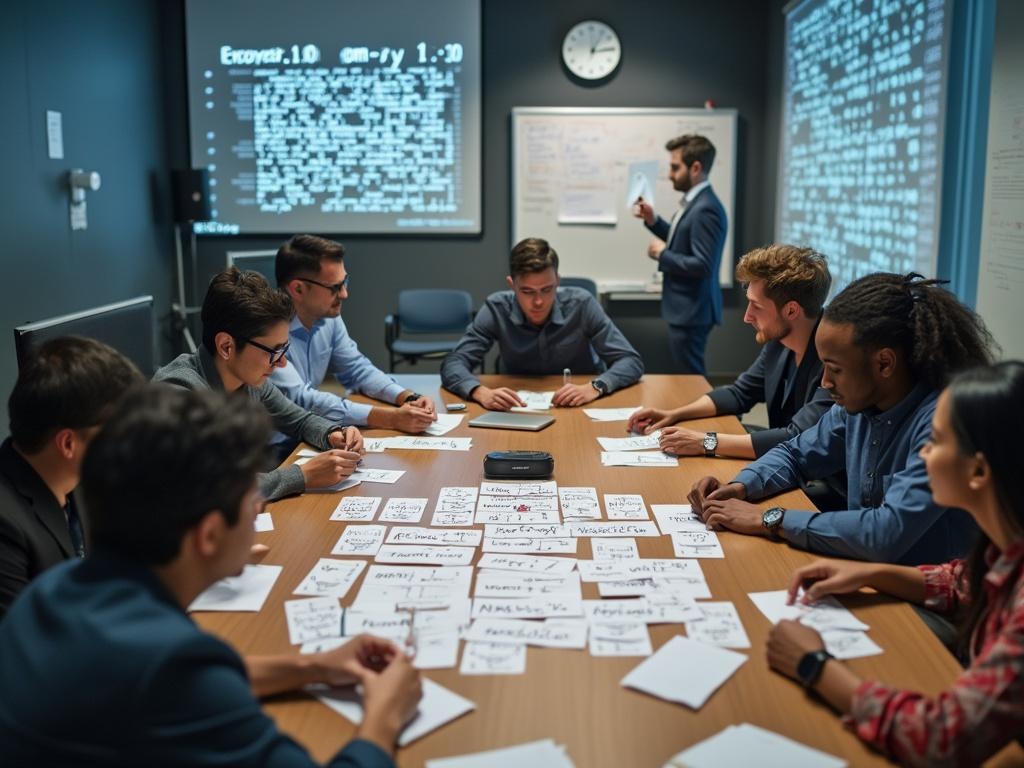
Team Building Problem Solving Games: Core Activities for Workplace Success
Team building problem solving games transform ordinary workplace interactions into powerful learning experiences. Activities like escape rooms, minefield navigation, and bridge building challenges create situations where colleagues must work together under pressure to reach specific goals. These engaging exercises—including the Lost at Sea scenario, Trading Game, and Code Break challenges—develop critical thinking while strengthening workplace communication strategies.
Business Impact: Why These Activities Matter in Corporate Settings
Team building problem solving games act as catalysts for organizational growth by addressing workplace challenges in a safe environment. When you implement these structured activities, your employees develop valuable skills in resource management, strategic thinking, and conflict resolution that directly improve project outcomes. These exercises also reveal natural leadership abilities, eliminate departmental barriers, and create psychological safety—essential elements for innovative corporate cultures that maintain a competitive edge in fast-changing markets. Team building problem solving games can transform how your team approaches challenges together.
These activities don’t just fill time during company retreats—they build fundamental capabilities that transfer directly to daily work situations. Your team members learn to leverage each other’s strengths while practicing the collaborative problem-solving that modern workplaces demand.
Teams that engage in problem-solving activities increase their collaboration and communication skills by an average of 35%, leading to better overall project outcomes.
6 Engaging Team Building Problem Solving Games: Unlock Collaboration and Creativity!
In today’s fast-paced work environment, effective teamwork is more crucial than ever. Engaging in team building problem solving games not only fosters camaraderie among colleagues but also enhances essential skills like communication, trust, and creative thinking. Whether you’re looking to boost morale or tackle real workplace challenges, these interactive activities encourage participants to collaborate and strategize effectively.
In this section, we’ll explore six dynamic team building problem solving games that provide a fun and engaging way to strengthen team dynamics. Each game is designed to address specific teamwork skills, making them ideal for various team scenarios. From the immersive experience of an escape room to the strategic negotiations of The Trading Game, these activities will help your team unlock their potential and enjoy valuable learning moments along the way.
1. The Escape Room Challenge
Escape rooms have become one of the most popular team building problem solving games in recent years. These immersive experiences require teams to solve interconnected puzzles and riddles within a strict time limit, usually 60 minutes. Your team’s success depends on how effectively members share information and delegate tasks.
To maximize your escape room experience, assign roles based on individual strengths. Some team members might excel at logical puzzles while others spot visual patterns more easily. Encourage open communication throughout the challenge.
These benefits make escape rooms particularly valuable:
- Enhances logical thinking and critical reasoning
- Improves time management under pressure
- Develops cross-functional collaboration skills
- Reveals natural leadership tendencies
Many companies now offer portable escape room experiences that can be set up in your office, making this team collaboration exercise accessible without traveling to dedicated facilities.
2. Minefield Navigation: A Trust-Building Team Challenge
Minefield Navigation stands out among team building problem solving games for its simplicity and effectiveness. In this activity, team members are blindfolded and must navigate through a field of obstacles using only verbal guidance from their partners.
This problem-solving exercise creates an immersive experience where objects scattered throughout the course represent real workplace challenges that teams must overcome together. The blindfolded participant must rely completely on their partner’s instructions, creating immediate trust and dependency.
Key benefits of this team building problem solving game include:
- Builds trust between colleagues when literal guidance is needed
- Improves communication clarity and precision in giving directions
- Develops leadership skills in the guiding partner
- Encourages teams to develop collaborative project strategies
- Reinforces the importance of active listening in high-pressure situations
To set up this activity, arrange various objects in an open space, ensuring there’s enough room for participants to maneuver safely. Partners should establish clear communication signals before beginning, which mirrors how teams need to establish protocols before tackling complex workplace challenges.
Expert Insight: In the Minefield Navigation challenge, blindfolded participants must rely on their partner’s verbal guidance to navigate obstacles, fostering trust and enhancing communication. This exercise sharpens leadership and active listening skills while underscoring the importance of collaborative strategies, making it a valuable team-building experience for addressing real workplace challenges.
3. The Bridge Build: Engineering Solutions Together
The Bridge Build stands as one of the most effective team building problem solving games for developing collaboration skills under constraints. In this challenge, teams must construct a bridge using strictly limited materials that can support actual weight when completed. Your team will need to tap into collective creativity while managing resources efficiently.
The activity typically works as follows:
- Teams receive identical sets of basic materials (paper, tape, straws, popsicle sticks)
- A budget constraint limits additional materials teams can “purchase”
- Groups must plan, prototype, and execute their design within a strict timeframe
- Bridges must span a specified distance and support predetermined weight
This exercise creates a perfect environment for project collaboration and teamwork as members must balance structural integrity against material limitations. The problem-solving aspects emerge when initial designs fail testing, requiring rapid adaptation and innovation.
Benefits of this team building problem solving game include:
- Promotes creative resource management under constraints
- Develops consensus-building skills when conflicting ideas arise
- Encourages prototyping and learning from failure
- Simulates real-world project challenges in a low-risk environment
Expert Insight: Utilize “The Bridge Build” activity to foster teamwork by encouraging creative problem-solving under constraints. This hands-on challenge not only enhances resource management and consensus-building but also simulates real-world project dynamics, allowing teams to learn from failure while collaboratively innovating solutions. Embrace adaptation as a key to victory.
4. Lost at Sea Scenario
The Lost at Sea scenario is one of the most effective team building problem solving games that challenges groups to make critical decisions under pressure. Teams are presented with a hypothetical shipwreck situation where they must rank 15-20 survival items in order of importance. This activity forces participants to analyze the value of each item within the survival context while building consensus through reasoned arguments.
To run this exercise effectively:
- Give teams a detailed scenario setting (e.g., “Your yacht has sunk in the Pacific Ocean”)
- Provide a list of salvaged items (compass, water, flares, mirror, etc.)
- Allow 10 minutes for individual ranking
- Give 20-30 minutes for team collaboration on rankings
- Compare team rankings to expert opinions (typically from naval or survival experts)
The true power of this exercise comes from the post-activity discussion. Teams reflect on how they made decisions, resolved conflicts, and utilized different expertise. Many facilitators find this particularly valuable for highlighting how teams handle conflict during problem solving processes and reach agreement when opinions differ significantly.
Expert Insight: To maximize the effectiveness of the Lost at Sea scenario, emphasize post-activity discussions where teams analyze their decision-making processes and conflict resolution strategies. This reflection allows participants to understand diverse perspectives within the team and improve collaboration. Highlight the importance of consensus building in critical situations.
5. The Trading Game: Strategic Resource Management
The Trading Game stands out as one of the most effective team building problem solving games for developing negotiation skills. In this activity, you divide participants into teams and distribute different resources to each group. Teams must then strategically trade resources to complete assigned projects or objectives.
The game typically includes:
- Each team receives a unique set of materials (like paper clips, rubber bands, markers)
- A project sheet outlining what each team needs to build or accomplish
- Trading periods where teams negotiate exchanges with other groups
- Multiple rounds that increase in complexity as the game progresses
What makes this game particularly valuable is how it mirrors real workplace challenges. As you implement strategic planning in your trades, you’ll quickly see how resource optimization becomes crucial for success. Teams must develop creative negotiation tactics and learn to identify the true value of different resources.
The Trading Game teaches participants to:
- Analyze resource requirements before making decisions
- Develop persuasive communication skills when proposing trades
- Adapt to changing objectives between rounds
- Balance competitive instincts with collaborative opportunities
This problem-solving exercise helps teams understand interdependence while practicing the art of mutually beneficial exchanges.
Expert Insight: Engage in The Trading Game to enhance negotiation skills and strategic resource management within your team. By analyzing resource needs and adapting tactics in a dynamic environment, participants will learn the art of persuasive communication and the importance of collaboration for achieving mutual goals and optimizing outcomes.
6. Code Break: Decoding Team Building Problem Solving Games
Code Break activities represent one of the most intellectually stimulating team building problem solving games available today. In this challenge, teams must work together to decipher complex codes by combining different clues distributed among members. Each participant holds a crucial piece of the puzzle, forcing genuine collaboration rather than individual heroics.
When implementing Code Break exercises, structure them with the following elements:
- A central encrypted message that requires multiple decoding techniques
- Distinct clue packets for each team member, making information sharing essential
- Staged revelation of hints to maintain momentum when teams get stuck
- Time pressure components that simulate workplace deadline scenarios
The time constraints in these activities create a productive urgency that mirrors real workplace challenges. Teams quickly learn that effective project collaboration requires systematic information sharing and coordinated problem-solving approaches.
Code Break exercises offer numerous benefits beyond the immediate fun factor. They enhance analytical thinking capabilities, improve information flow between team members, and strengthen coordination in pressure situations. You’ll notice immediate improvements in how participants approach complex problems collectively rather than individually, creating lasting impact on workplace collaboration.

Team Building Problem Solving Games
Team building problem solving games like Escape Rooms, Minefield Navigation, Bridge Build, Lost at Sea, Trading Game, and Code Break activities offer engaging ways to develop essential workplace skills. These six immersive challenges require participants to collaborate under pressure while solving complex problems, enhancing both individual capabilities and team dynamics.
Benefits of Team Building Activities
Team building problem solving games create structured environments where business teams can practice crucial workplace skills outside the constraints of day-to-day operations. These activities provide organizations with cost-effective opportunities to:
- Identify leadership potential
- Improve communication patterns
- Strengthen trust between team members
- Develop strategic thinking capabilities
These skills directly transfer to workplace challenges and drive organizational performance.






